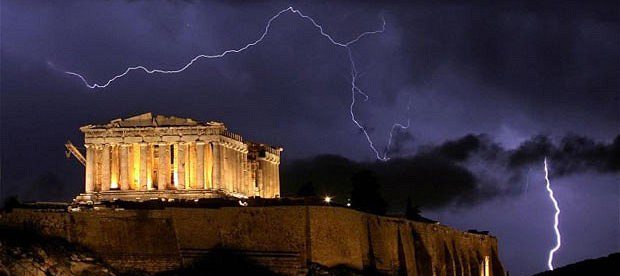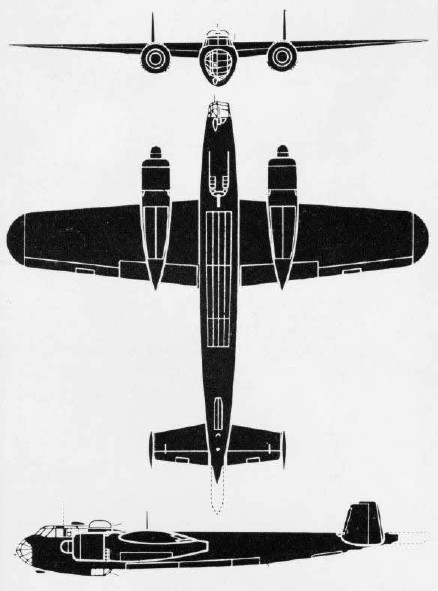The Aberdeen Mittwoch Blitz –
Wednesday 21st April 1943 Between 22.17 & 23.04pm
A Twin‑Engine high‑winged Monoplane with twin Fins & Rudders, the Dornier 217 was of conventional all‑metal construction. It carried a Crew of 4, Pilot, Observer, Radio Operator/Air Gunner & Ventral Gunner. The Observer, as well as Navigating the Aircraft, was responsible for Bomb Aiming & Firing the nose‑mounted Flexible Gun on the rare occasions it was used. The positioning of the Crew close together in the Nose made for Efficiency. During Operations, a lot of Information could be conveyed by Signs or by Pointing. This minimised the distractions caused by ‘Intercom Natter’.
Stavanger Airport, Sola is Norway’s oldest Airport, opened by King Haakon VII 29th May 1937. The Airport was the 2nd to have a Concrete Runway in Europe. The Airport was Attacked & Captured by German Fallschirmjägers from 1st Battalion of the 1st Regiment, 7th Flieger Division supported by Luftwaffe Aircraft WW2. During the War, the German Occupation Forces & Luftwaffe expanded the Airport considerably, as it was a vital strategic Asset for the Germans. Former anti-Aircraft positions are also still visible along the neighbouring Beach Solastranda.
‘The Big Blitz‘ in Aberdeen,
– major damage was done to the City during its worst Air Raid of WW2, Wednesday 21st April 1943.
Contemporary Shots of the same Locations were featured alongside the Bomb Damage to illustrate powerfully the devastation caused by a Squadron of 30-Luftwaffe Dornier 217E’s of Kampfgruppe 2, Flying from Stavanger that Night. Hitler appointed General Major Dietrich Pelz as Attack Leader, 125-people were killed in Aberdeen after 30-German Dornier 217s from the Elite KG2 Squadron attacked the Granite City. It was also the last German Raid on a Scottish City during the War.
Inset Dornier Do.217E from 1940 ~
21st April 1943 (Wednesday)

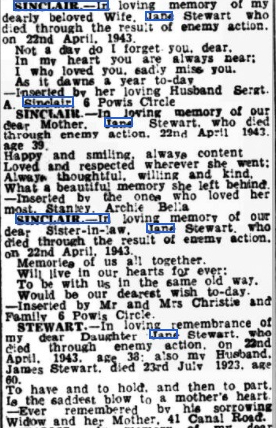
Jane Mary Falconer Benzies Sinclair aged 38-yrs nee Stewart wife of Cpl Archibald Sinclair and also known as ‘Jeannie‘ was Strafed by 15mm Gunfire from the Bomber Front Gunner, a Dornier 217E Enemy Aircraft Raiding from Stavanger in Nazi Occupied Norway.
She was likely running to the Concrete Air Raid Shelters built in Powis Circle, she died of her stomach wound(s) at Foresterhill Hospital on 22nd April 1943. She was then living with her Sister-in-law Magdalene Christie at a Council House in 6-Powis Circle while her husband Archie was a Corporal in the Army.
The Attack was the worst of 34 separate German Air Raids on Aberdeen City. She was buried at Trinity Cemetery in Aberdeen. They had 2-sons, Stanley, Archie & a daughter, Bella. Husband Archibald was later promoted to Sergeant. The 19-yr-old Jane married 20-yr-old Archibald Wilson Sinclair. Jane was listed at staying at 101-Commerce Street Aberdeen, and Archibald at 122-Park Street in Aberdeen. Jane worked as a Fish Worker & Archibald as a Fish Buyer.
Marital Accommodation in Aberdeen was then in very short supply and Jane (also known as Jeannie) was staying with her Sister-in-law Magdelene (nee Sinclair) at the time of her death..

21st April 1943 was a Wednesday –
I should know – I was there – age 14 – playing in my mother’s Band in a Ballroom in the City Centre. Fortunately – we were not injured – but had difficulty getting home – no Buses or Trams – we had to walk 2-miles through the Debris – carrying our Band Instruments etc.
Jack Sinclair MVO (Member of The Royal Victorian Order)
The Jack Sinclair Scottish Showband
Beach Ballroom – 1946-2002
Station Hotel – 1961-78
Treetops Hotel – 1978-95
Grampian Television – 1961-78
Balmoral Castle & Birkhall – 1950-2000
BBC Radio – 1946-2001 –
Northsound Radio – 1981-2013.
– and the “Day Job” – and I’m still alive & kicking!! Jack Sinclair MVO. A Blue dominant Tartan was designed by Maureen Sinclair for the personal and exclusive use of her Husband, John Gordon (Jack) Sinclair MVO, and their immediate Family. It was based on the Ancient Hunting Sinclair and approved by the Earl of Caithness. Jack Sinclair, the Scottish Showband leader, performed many times for the Royal Family at Balmoral over 51-yrs. He wore this Tartan for his Investiture at Buckingham Palace in December 2001.
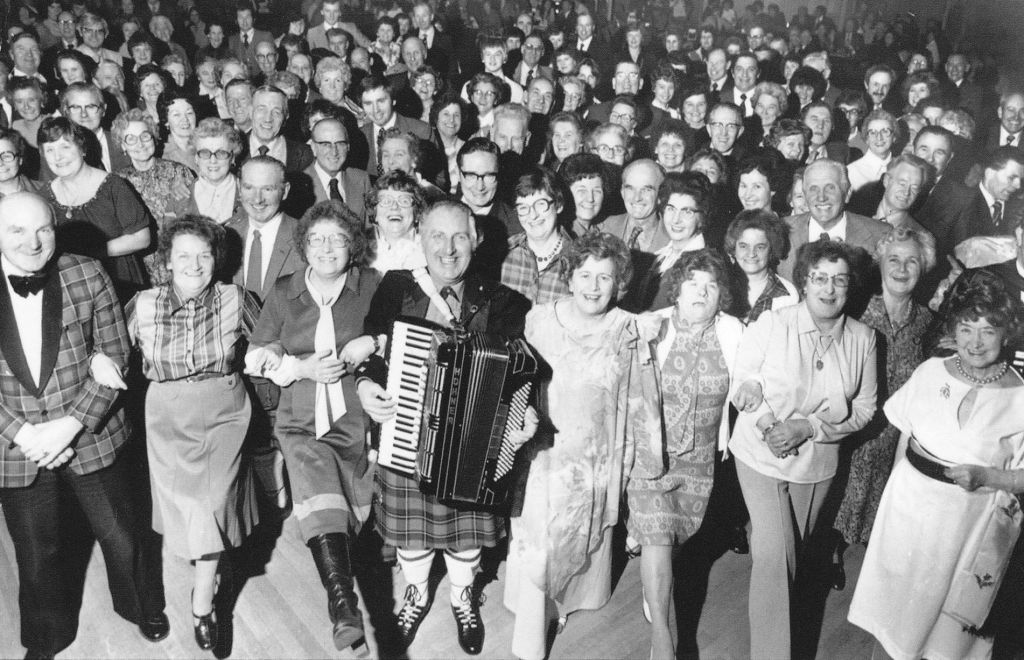
The Statistics for the Night of 21st April 1943
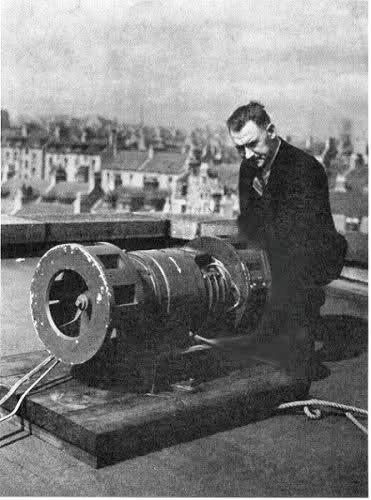 127 Bombs dropped (mixture of Incendiary, High Explosive and Cluster Bombs)
127 Bombs dropped (mixture of Incendiary, High Explosive and Cluster Bombs)- 98 Civilians killed
- 27 Servicemen killed at Gordon Barracks
- 93 Serious injuries
- 139 Slight injuries
- 9,668 houses damaged
The following Facts show how Aberdeen earned its gruesome War-time Nickname of ‘Siren City‘, the most frequently Bombed area in the UK.
- Attacked by Luftwaffe 32 times
- 364 Air Raid Warnings
- 7-Raids without warning
- 265 High Explosive Bombs fell (250-500kg)
- 100 Incendiaries fell
- 78 houses were completely destroyed
- 117 houses were irreparably damaged
- 828 houses badly damaged by repairable
- 12,175 houses sustained some slight damage
The Battery Gunners have fond memories of the Aberdonian’s as a generous & welcoming people. In particular, they mention Mrs Douglas from Douglas Farm at Torry Point. Her son was in the RAF as a Fighter Pilot and was KIA early in the War. Mrs Douglas would lend the Battery Troops his Records & Gramophone Player. There were earlier Raids on Aberdeen. While 6 LAA Battery were there between 1939–1940. They were manning Lewis Guns and had Telegraph Poles made to look like Heavy Guns

Torry Fire & Police Station, 1891
The 1st Fire Station in Torry was located at the Junction of Victoria Road & Sinclair Road. This was a wooden building which incorporated Police Cells, as well as fire hose reels and hand-drawn Ambulances. The decision to erect this building had been taken as a consequence of the Amalgamation of Torry (along with Woodside & Old Aberdeen) into the City of Aberdeen in 1891. Prior to this, the area had come under the jurisdiction of Kincardineshire Police. Chief Constable Wyness planned a series of Sub-stations to be erected across the City. The one in Torry was made of Teak and similar to Glasgow’s sub Police Stations.
Torry Police & Fire Station, 1898
In 1898 the Station was moved to the Torry Side of Victoria Bridge. Today the Site is occupied by a Café. The building again housed both a Fire Station & a Police Station. The sub-Fire Station was equipped with 2 Handcarts, 1 with a 250ft hose reel, whilst the other carried 300ft of Hose and 2 small Ladders. The Fire Station continued in use until the early 1920s when all sub-Stations within Aberdeen were closed and the Fire Service became fully Motorised.

Auxiliary Fire Stations, WW2
Immediately prior to the Outbreak of Hostilities, in 1939, 9-locations within Aberdeen were selected to be Auxiliary Fire Stations. In Torry, the Site was Cordiner’s Garage on Menzies Road. A number of part-time Firemen were subsequently Trained up & allocated to each of the Auxiliary Stations. The Auxiliary Station was issued with Trailer Pumps which were towed by specially adapted Civilian Saloon Cars. Of the Fires attended by the Firemen from Cordiner’s perhaps the most notable was that at Victoria Road School on 30th June 1940, which had been caused by a German Incendiary Bomb. Inset – This was a Voluntary Service. Robert Fergus Abercrombie (2nd from left) was Firemaster. c.1940.
Bombs also Landed in the Gordon Barracks at the Bridge of Don, killing 27-Soldiers. That evening a total of 29-Dornier 217s of Kampfgruppe 2, Flying from Stavanger, dropped Bombs in and around Aberdeen, killing a total of 98 civilians.
Barracks Hit – The Bridge of Don Barracks was the home of the Local Regiment from 1935 to 1960.
The Barracks were struck by the Air Raid on 21st April 1943.
27-Servicemen died and a further 26 were injured.
In time it became the Training Depot of the Scottish Division.
20 HE [High Explosive Bombs] 11 Incendiary (6 Sprengbrande [Incendiary Bomb with a delayed action TNT charge] 5PH.IB [Phosphorous Incendiary Bomb]) Gordon Barracks, Balgownie Links, D C Stewart’s Yard, Joss & Sons Garage, Grandholm Works, Scotstown Wood and on 7-Farms. Damage to Corn & Grass fields. Extensive damage to Steadings & Farm houses. Extensive damage to dwelling houses. Foodstuffs damaged. 10-Families rendered homeless.

The hazards of Blackouts. – He was a “runner” for the ARP Wardens in the Town and carried messages from one Post to another on his bike, as you can imagine it was pitch black at night, however this was compensated for by knowing the streets well. The thing that he hadn’t allowed for was that Trams would stop in strange places when the Power was cut, so one evening on an errand he raced round a corner straight into a Stationary Tram resulting in a broken arm & several other bruises!
In 1943 there was widespread damage at Cattofield, pupils died at Sunnybank Primary School, at Broadford Works the Mill was destroyed. ‘Soapy’ Ogstons also went.
I was in Aberdeen during the War staying with relatives who had a Butcher’s Shop in Broomhill Road (Wm Turnbull Master Butcher) When Indian Troops were Training at Milltimber House he had a contract to supply them with Mutton. I accompanied him on several Deliveries and was given my 1st taste of curried mutton on pilau rice almost 60-yrs ago and I’ve enjoyed Indian food ever since. These Troops were from an Indian Mountain Battery with their Mules they were Training on Lochnagar before moving to Italy. The last time I was at Milltimber in the 60’s it was still possible to see where the old Mule Lines were but so much rebuilding has probably obliterated any traces now.
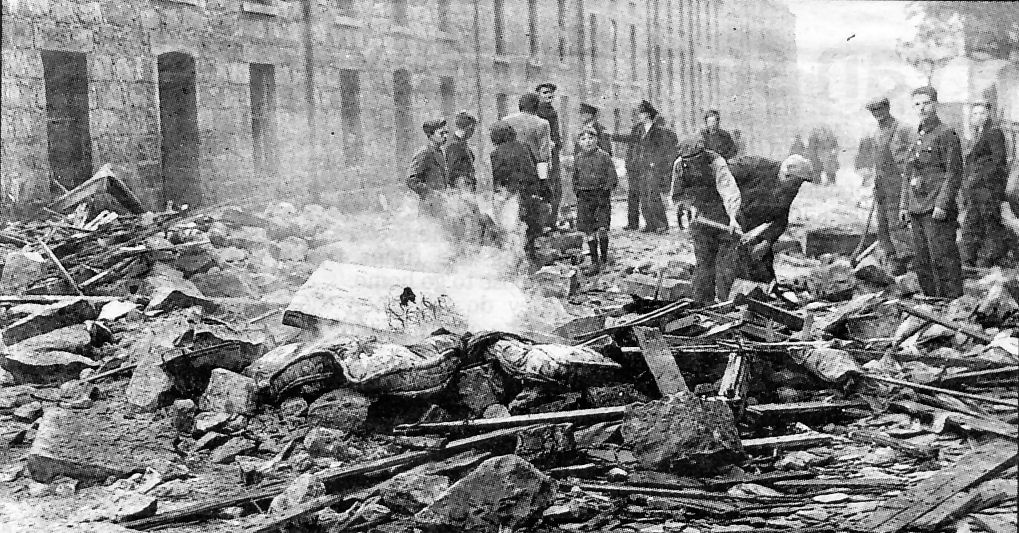
Workers clearing Debris on Stafford Street, off George Street Aberdeen, after the Bombing Raid on 21st April 1943 imagine those Granite blocks raining down on your person. The Story which really brings a tear to the eye are a man from 5-9 Stafford Street, which was hit by 2-Incendiary Bombs in short succession – out in the Street with his neighbours after they had all been Rescued from the Cellar after the 1st Bomb, decided he would go back and collect his Boots as his feet were bare. While he returned to the Tenement, the 2nd Bomb struck, engulfing the Building in an Inferno. He was never seen again.

In 1943 I was 8-yrs-old and living in Aberdeen. One night my sister & brother-in-law (who was Home from the Navy) had a night out together and my mum and I offered to babysit at their House. The Sirens went off because German Planes were coming over and we scuttled home to Sandilands Drive in Woodside. My mum wanted to be back in her own home. We got as far as Commerce Street, stopped in a doorway, and saw a German Plane with its Pilot coming over. We walked up to Stafford Street and saw that there had been a Bomb dropped there. A young girl was screaming for her mum who was in a Tenement. We got as far as Kittybrewster School and my brother met us. He picked me up, put me on his shoulder and took us home. My mother was very relieved to get home safely.
A sad reminiscence from the Residents of no’s 5-9 Stafford Street: by going down to the Cellar to escape from the Bombs, they were trapped under the rubble as the Tenements got a direct hit, and a hit in the road damaging the Frontage of No.6 – the people were brought to safety by Swanson MacKenzie‘s father; Swany’s Granny was one of the Residents, and because of the barking of their Dog, they were found. One of Granny Mackenzie’s neighbours ran back into the undamaged part of the Tenement to collect his Great War Medals, but that was when the 2nd Incendiary Bomb struck, turning the Street into a fireball – the man was never seen again.
The Night of the Aberdeen Blitz I was on my way Home to Bannermill Street, Footdee after the Dancing at Locarno in George Street. It was the night of the worst Bombing in Aberdeen and I walked past the worst of the damage. It was where the Bon-Accord Shopping Centre is today. I lost friends who lived there that night. On VE Day we lit a Bonfire on the Broadhill and walked from there up to the Harbour. It was pouring rain & freezing cold. We danced a huge Eight-some Reel at the top of Market Street where the Traffic Lights are today, there were 100s of us. The atmosphere was just wonderful.
21st April, 1943
The most prolonged Air Attack against Aberdeen takes place at 10:17-pm on the 21st of April 1943. Over 130 individually noted Explosive Devices fall on Aberdeen, including High Explosive, Phosphorus & Cluster Bomb sub-munitions.
A Cluster Bomb carrying 50 sub-Bombs detonates over Catherine Street.
1 – 500 KG High Explosive Bomb falls on Charles Street.
1 – 500 KG High Explosive Bomb falls on Fraser Place.
Cluster Bomb submunitions & 1-Phosphorus Bomb fall near Hutcheon Street on George Street.
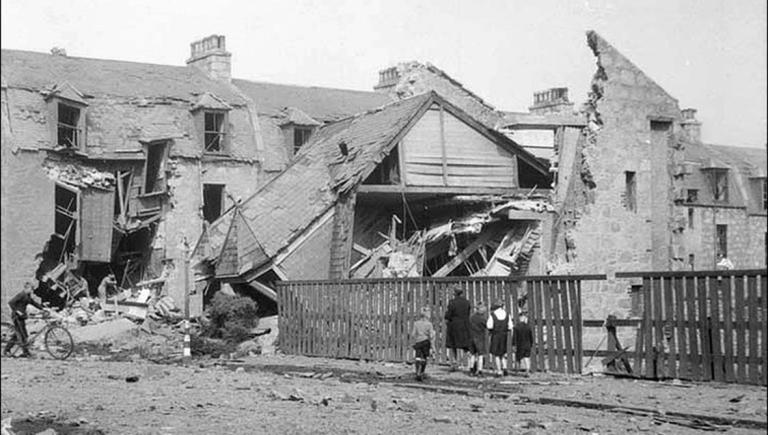
500 KG High Explosive Bomb causes damage to Powis Place & Causewayend Church, as well as to Houses in Charles Street.
500 KG High Explosive Bomb falls on Elmbank Road, Froghall.
BedfordPlace
500 KG High Explosive Bomb falls on Bedford Place, (near Powis).
500 KG High Explosive Bomb falls next to 2-Houses on Erskine Street, (near Bedford Road).

500 KG High Explosive bomb falls on Bedford Road.
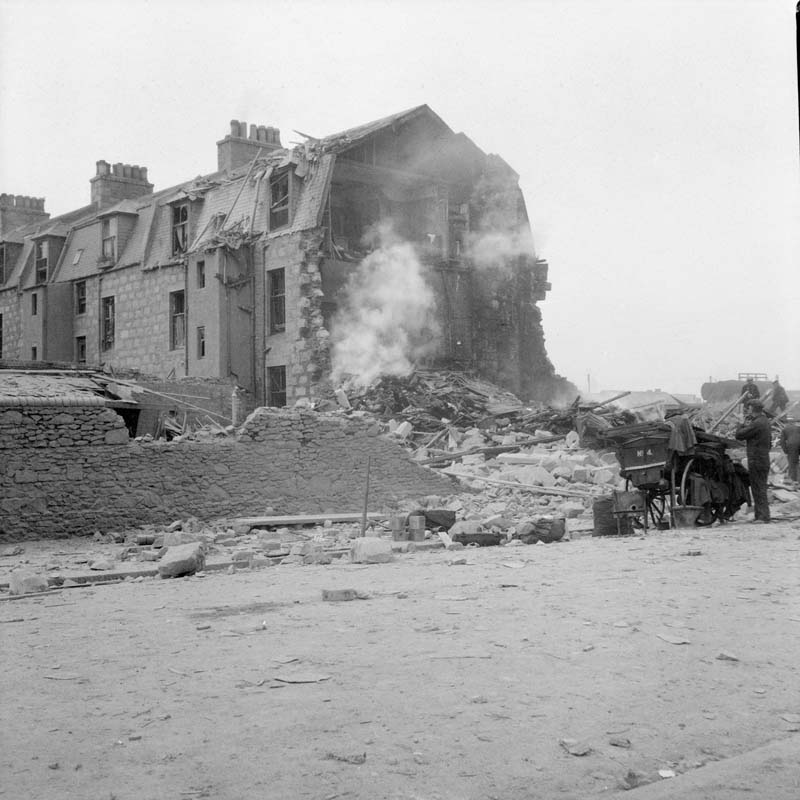

50 SBC Cluster Bombs fall in front of and behind a House in Erskine Street. One Lands in the Garden, fails to Detonate, and later has to be removed with submunitions still intact. Phosphorus Bomb Lands on the Roof of a house in Erskine Street and fails to Detonate.
50-kg High Explosive Bomb falls on Robert Gordon’s College building at Schoolhill.
50-kg High Explosive Bomb falls on Church of Scotland Teacher Training School in Charlotte Street (near John Street).
250-kg High Explosive Bomb falls on Maberly Street.
500-kg High Explosive Bomb falls on Hutcheon Street.
500-kg High Explosive Bomb falls on Hutcheon Street, Central Meat Market.
50-kg High Explosive Bomb falls on Stafford Street.
Cluster Bomb falls on Holland Street.
500-kg High Explosive Bomb falls on Richards’ Works at Maberly Street.
500-kg High Explosive Bomb falls in Field to South of Cairncry Road, and fails to Detonate.
Cluster Bomb Detonated over Railway Line opposite Leslie Terrace.
500-kg High Explosive Bomb falls on Railway Line South of Powis Terrace.
Cluster Bomb detonates East of Kittybrewster Station.
Phosphorus Bomb detonates over Railway.
500 KG High Explosive Bomb falls in Grounds of Royal Infirmary, Foresterhill but does not detonate.
500 KG High Explosive Bomb Lands in Allotment North of Ashgrove Road West, but fails to detonate.
500 KG High Explosive bomb falls in meadow North of Cornhill Road and does not detonate.
Cluster Bomb detonates over Kintore Place & Mount Street.
Cluster Bomb and Phosphorus Bomb fall on Westburn Road (near Mount Street).
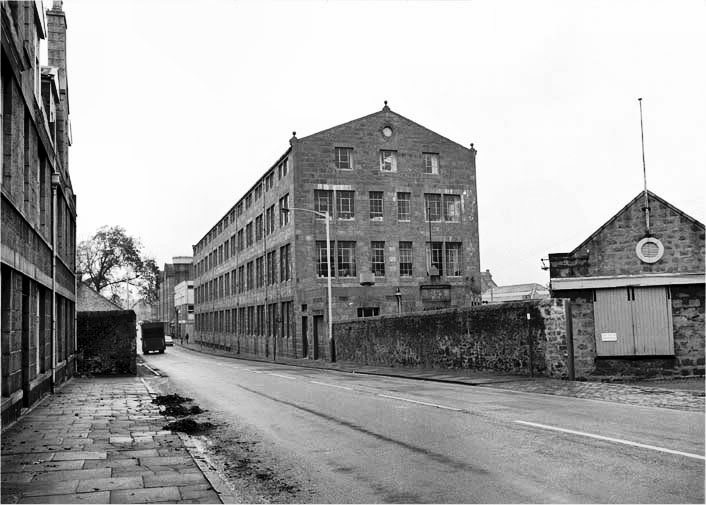
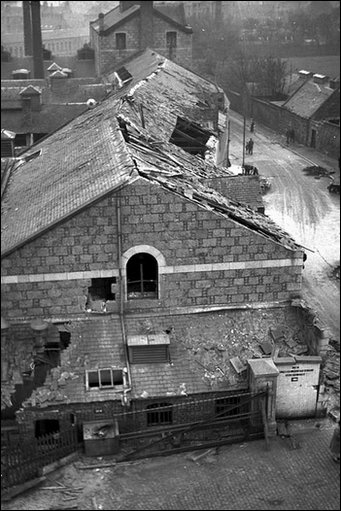
Cluster Bomb falls on Kilgour & Walker, Berryden Mills.
Phosphorus Bomb falls on Northern Co-operative Society Building on Berryden Road.
500 KG High Explosive Bomb falls on Northern Co-operative Society Bakery & Bread Store.
Betty Jardine started work at the Co-op Bake House in Berryden Road before the end of 1940. She initially filled pans with dough, but then worked for nearly 2 years packing biscuits. Betty and her sister, Chrissie, were at their Aunt’s shop in Jamaica Street in the evening of 21st April 1943, when the heaviest Wartime raid on Aberdeen suddenly started. They sheltered under the Shop counter, while Bombs landed all around them: in George Street, Bedford Road, Causewayend and Berryden Road, but luckily none in Jamaica Street.
500 KG High Explosive Bomb falls in a Field behind the Northern Co-operative Bakery.
The Mental Hospital is Bombed – 1 x 500 kg High Explosive Bomb falls on the Female Ward, 1 x 500 kg High Explosive falls on the Female Villa, a Cluster Bomb detonates over the Nurses’ Home, a 50 kg Phosphorus Bomb strikes the outer wall of the Doctors’ Garden, and High Explosive & Cluster Bombs Land in the Grounds of the Hospital.
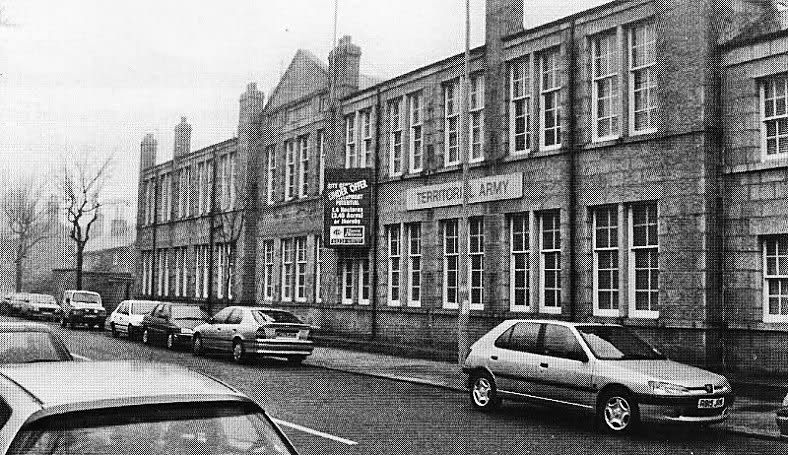
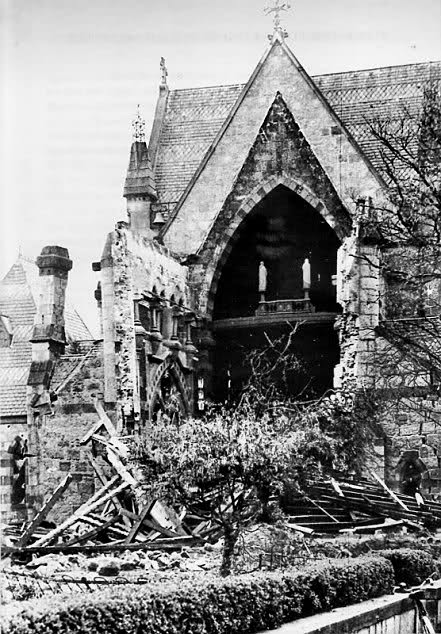
500 kg High Explosive Bomb falls on Fonthill Territorial Barracks, Fonthill Road
500 kg High Explosive Bomb falls on Ashvale Place.
500 kg High Explosive Bomb falls on St Mary’s Church at the corner of Albert Terrace & Carden Place. The Bombing of the Tartan Kirkie in Carden Place. On the 21st of April 1943 a Bomb was dropped on St Mary’s, the Chancel, Crypt & Sacristy were badly damaged, the windows were blown out, and the walls were badly cracked. The triptych had fortunately been removed, so survived the blast. A new Chancel was built in 1952 with the aid of the War Damage Commission and the congregation.
250 kg High Explosive Bomb falls on Kingshill Avenue.
50 kg SC Bomb dropped on Angusfield Works.
50 kg High Explosive Bomb falls on King’s Cross Terrace
50 kg High Explosive Bomb falls on Angusfield Avenue.
8 Bombs – 2 Cluster Bombs, 2-Phosphorus, and 4 x 500 kg high explosive, are dropped South of the Main Drive at Seaton House. Two of the Bombs do not detonate.
3 x 500 kg High Explosive Bombs, 1 Phosphorus Bomb, and 1 Cluster Bomb fall in St Peter’s Cemetery.
500 kg High Explosive Bomb falls on Merkland Place.
2 SBC 50 Cluster Bombs, 1 Incendiary Bomb, 1 x 250 kg General Purpose Bomb, and 1 x 500 kg High Explosive Bomb fall on houses in Hilton Terrace.
500 KG High Explosive bomb falls on Cattofield Place.
Phosphorus & Cluster Bombs are dropped in the South-east corner of the Royal Mental Hospital.
2 x 500 kg High Explosive Bombs fall in the roadway and open fields near Westburn Drive.
2 x 500 kg High Explosive Bombs fall on Westburn Park. One Lands on the Bowling Green and does not detonate.
Westburn Drive “a stick came down in the street”, one in the road just outside these houses (Nos. 9 & 11), one opposite No.15, and 2 in the Public Park opposite. One of these, in the Bowling Green, was almost opposite her Family house. This caused some consternation later – ARP thought it had gone off, but it hadn’t – when the hole drained the fins emerged very much intact as a UXB…oops…evacuate! There were a lot of UXBs, maybe because so many were dropped very low and did not correctly fuse. Houses were not too badly damaged, even by near misses, as they were made of good Aberdeen Granite.
Phosphorus & Cluster Bombs fall on the same House on Charles Street.
Cluster Bomb fails to detonate over Elmbank Terrace.
500 kg High Explosive Bomb detonates to the West of Kittybrewster Station.
Phosphorus Bomb falls on South Mount Street.
500 kg High Explosive Bomb falls in Allotments at Kittybrewster.
500 kg High Explosive Bomb detonates immediately to the West of Kittybrewster Station Repair Shop.
Kittybrewster Station Area: 2 x 500 kg Bombs detonate on Kittybrewster Station ARP Shelter and the Olympia Garage. A 3rd 500 kg High Explosive Bomb detonates 280 ft South East of the Station.
500 kg High Explosive Bomb detonates on a House in Powis Place
500 kg High Explosive Bomb detonates after falling in a field by Long Walk Road.
500 kg High Explosive Bomb detonates after falling in a field North of Ashgrove Road West. Location uncertain – this marked area is representative rather than definitive.
3 x 500 kg High Explosive Bombs detonate in Stewart Park, one landing directly on Hilton Bowling Club.
2 x 500 kg High Explosive Bombs and 1 x 50 kg Phosphorus Bomb fall on Middlefield School.
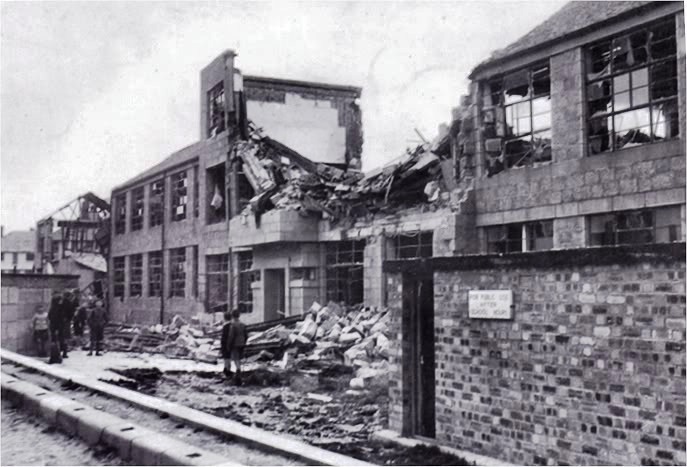
The Blitz
It was 21st April 1943, the night of the Aberdeen Blitz. I was blown out of my bed and under the table. Our budgie, Jocky, was thrown around his cage and never spoke another word after that. As Ma ran down the Lobby trying to get out, Da threw himself on top of her, shouting: “Annie, keep doon! As we fled down the Stairs through smoke & dust, heading for the back-garden Concrete Air-raid Shelter, the door on the bottom floor opened and we were dragged inside. “Dinna gae oot! They’re Machine-gunnin’ the place!” There was a bunch of us lying on a Lobby floor covered with coats. Outside, at the front door our elderly Lady ARP Warden was standing screaming with fright. It went on for hours, the noise. Big bangs, the double-droning of the German Planes, shuddering impacts. I was unworried, because I had identified the sound of a Mustang Fighter. “Dinnae worry,” I said. “Rufus is up. He’ll get them!” Rufus? I don’t know how it came about but all we kids knew for an absolute fact that a Fighter Ace called ‘Rufus’ was at Dyce RAF Station, and he could deal with anything! It ended eventually, but in the morning I discovered that 2 Bombs had hit my School, Middlefield Primary. It was wrecked. One of my favourite Teachers, Miss Spicer, had been on Fire-watch Duty. As she tried to flee the Attack, the Lintel above the Main Door fell on her and she lay trapped all night. She lost a leg. (She came back, complete with wooden leg, to Teach for many years after.)

Nae School I’ Day – Middlefield School Bomb Damage 21st April 1943 during WW2
The School had been wrecked. Actually, my Room 19 was still almost intact, but my Desk had been shattered by the impact of an unexploded Incendiary Bomb. Anyway, we were all asked to go through the ruins to salvage anything we could. We spent a whole day at the job gathering together books, pens, blackboards . . . the lot. But we also gathered up straps. Straps? They’re known in other parts of Scotland as the Tawse – vicious, thonged Leather Belts used for Corporal Punishment. We found dozens of ’em. We buried ’em. But when we eventually got back to Middlefield, we found that all the Teachers had been issued with new, and even more Vicious, Straps. These were leathal for both Teacher & Pupil in as much as the leather thongs hit the arm beyond the Palm on the tender wrist skin and drew blood and bruising as a result of Teachers over-reaching in anticipation of the hand being withdrawn and thus striking their own legs.
500 kg High Explosive Bomb detonates on houses at Cummings Park Road.
250 kg High Explosive Bomb detonates at rear of houses on Provost Rust Drive.
SBC 50 Cluster Bomb falls on House at Newton Road facing onto Danestone Circle but does not detonate.
SBC 50 Cluster Bomb detonates over Smithfield Drive, 140-ft South of Fairlie Street.
50 kg Phosphorus Bomb detonates on roadway at North Anderson Drive.
SBC 50 Cluster Bomb falls on Houses on the Northside of Western Road. a 500 kg High Explosive Bomb detonates on the Houses on the opposite side of the Street.
SBC 50 Cluster Bomb detonates adjacent to Gordon’s Mill Buildings.
SBC 50 Cluster Bomb detonates in front of the Manager’s House at Don Paper Mills.
500 KG SC (General Purpose) Bomb falls on Ashgrove House, South of Ashgrove Road.
SBC 50 Cluster bomb detonates over House on Charles Street.
50 kg Bomb detonates causing damage to House in Church Street, Woodside.
500 kg Bomb detonates on Western Road Boys Club, (near Hilton Drive)
SBC 50 Cluster Bomb detonates over House on Marquis Road.
500 kg Bomb detonates on the Eastside of Summer Street.

500 kg General Purpose Bomb detonates on Northside of Brown Street, Woodside.
500 kg Bomb detonates on houses at Tanfield Walk.
250 kg Bomb detonates on house at Clifton Road & SBC 50 Cluster Bomb detonates over the junction between Clifton Road & Hilton Road.
SBC 50 Cluster Bomb detonates over houses on the East end of Hilton Road.
50 kg Bomb hits Maberly Street Electric Sub-station but does not detonate.
50 kg Bomb detonates behind a house in Charlotte Street.
250 kg Bomb falls in Charles Brands‘ Yard in Fraser Place and SBC 50 Cluster Bomb Detonates over the middle of the Street.
SBC 50 Cluster Bomb and 50 kg Phosphorus Bomb detonate over Houses in Printfield Walk.
50 kg Phosphorus Bomb falls on House in Ferrier Crescent.
Various Books exist featuring Aberdeen’s Wartime experience; 2 were Far Were Ye Fan the Sireen Blew, by David Atherton & Trevor Davies, published by Aberdeen City Council, c. 1998 and Aberdeen at War, by Paul Harris, published by Lomond Press, 1987. See also Aberdeen & the North-East at War by Bernard Bale, published by Aberdeen Journals, 2005. The main data on the amount of Bombs which fell and their locations came from a combination of a City Council ‘Memorandum of Information’ and the ARP listings – both of which can be consulted at the Local Studies Deptartment of Aberdeen City Library, Rosemount Viaduct.

World War Two
Is thon the Bombers comin?
Is thon the Siren’s wail?
Wi the Black oot, aathing’s hidden
Bit they will drap a Shell
On Pittodrie, Torry, Seaton,
If the slichtest licht they see
I maun hurry tae theSshelter
They micht drap a Bomb on me!
Is thon the wikkly Shoppin?
Carrot cake an breid an jam?
Oh it’s queues, mair queues, an Rationin‘
An Tins an Tns o’ Spam
Uncle Alex oot at Udny’s
Nearly oot the Door wi fleas
Since a Trainie frae the Gorbals
Brocht him Ten Evacuees.
Is thon the Evenin Paper?
Is there ony word o Da?
He’s Fechtin Hitler’s Nazis
In a Country hyne awa
Mr Churchill said he hid tae,
Sae the Warld micht be Free.
I winner fit oor Bombers dae
Tae Bairns in Germany?
248 Squadron also staged the last Air Battle in Europe, which was Fought off the Aberdeenshire Coast on 21st April, 1945. Mosquitoes from the RAF Banff Strike Wing intercepted 18-Torpedo Bombers – it was reported only 4 made it back to Norway. Cannon Fire from a De Havilland Mosquito FB Mark VI of No.248 Squadron RAF strikes the Fuselage of a Junkers Ju 88, during an interception of a mixed Formation of 18 German Torpedo Bombers by 45 De Havilland Mosquitos of the Banff Strike Wing over the North Sea. The Mosquitoes sighted the Formation about 150-miles from the Scottish Coast while returning at Dusk from an uneventful anti-Shipping Patrol in the Kattegat. They succeeded in Shooting Down 9-Enemy Aircraft without Loss to themselves.
Bombing Incidents Map in Aberdeen 1939-45
